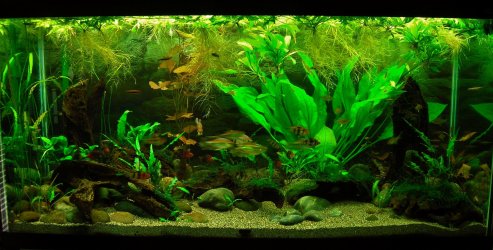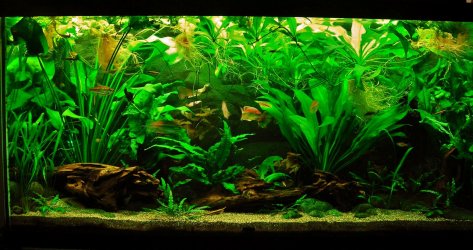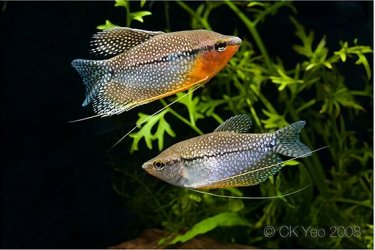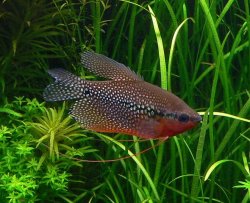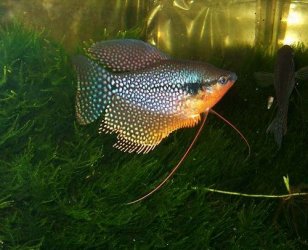rainbowfish are large and colorful but you don't meet the ph and kh/gh requirements here. and they need a heavily planted tank.
I don't know anything about sharks as im more of a dutch style aquarist (new word huh) which requires fish that are small and can school a bunch, and some others but not sharks lol
With sharks though I did do some research and found this :
Red Tail Sharks and Black Tail Sharks
The Red Tail and Black Sharks are two variations of the Labeo subspecies of Cyprinids. They tend to be aggressive toward other sharks, or shark-like fishes and should be kept in a tank without any other fishes of this type. Suggested tank size is 40 to 55 gallons or larger. In a much larger aquarium (90 gallons or more), it is possible to keep more than one of these sharks, as they will claim different territories. Red Tail and Black Sharks like to stay hidden in caves or beneath thick vegetation near the bottom of the tank. As bottom dwellers they spend their time foraging the bottom and scavenging for food.
The Red Tail Shark is one of the most common freshwater aquarium sharks; it is widely available and offered with some distinctive variations. The most common variant is in tail color, which can range from a vivid red to almost pure orange. The male of the species will show the same color in its dorsal and pectoral fins while the female will have color only on the caudal fin. The rest of the shark is a velvety black color. The Black shark is completely black and velvety. Albino versions of these sharks are rare but do exist and follow the same care needs as fish of the standard coloration.
These sharks can attain sizes as long as six inches and live for eight to ten years in optimal conditions. They can survive in most home aquariums but prefer ones with a pH between 6.8 and 7.6, so they are not often kept in Cichlid tanks. Temperatures should be kept in the 72°F to 79°F range but the sharks have been known to survive in a range from 66°F to 87°F.
Rainbow sharks are widely available in both regular and albino varieties.
Rainbow Sharks
The Rainbow Shark is also a very popular freshwater aquarium shark. Although similar to the male Red Tail Shark in appearance, the Rainbow Shark has a longer more cylindrical body often with a dark-green tint to it. The body color can also vary from an almost silver to a deep green-black. All of the fins on the Rainbow Shark are red or orange with variations similar to those in the Red Tail sub species. There is a very common albino of this species that has the same needs as the standard variety.
The rainbow shark grows to about seven inches in an aquarium setting and prefers a tank of at least 29 gallons. It is extremely aggressive toward other similar sharks (bala shark, red-tailed shark and black shark) and should not be kept with them. Rainbow sharks are omnivorous bottom feeders that prefer vegetable matter to live foods, although they will eat tubifex worms and bloodworms readily. They are voracious algae eaters and will help keep tanks clear of algae on all surfaces.
They like tanks with several plants and caves to scurry around. The best temperature for Rainbow Sharks is in the 72°F to 79°F range but the sharks have been known to survive in a range from 66°F to 87°F. In respect to the pH level, the rainbow shark is a bit more tolerant of lower pH than the red tail shark thriving from 6.5 to 7.0 but happy anywhere from 6.0 to 8.0.
These sharks can attain sizes as long as six inches and live for eight to ten years in optimal conditions. They can survive in most home aquariums but prefer ones with a pH between 6.8 and 7.6, so they are not often kept in Cichlid tanks. Temperatures should be kept in the 72°F to 79°F range but the sharks have been known to survive in a range from 66°F to 87°F.
Bala sharks can quickly outgrow most home aquariums and are better suited for ponds.
Bala Sharks
The Bala shark is a torpedo shaped silverfish with striking black edges to its caudal, dorsal, anal and pelvic fins. It grows to approximately one foot long in a home aquarium (16 inches in optimum conditions), so keeping it in at least a 55 gallon tank is a must. The Bala shark is a very sociable fish and prefers to live in a shoal, although that would require a much larger tank, upwards of 200 gallons.
As a mid-level swimmer, this freshwater aquarium shark will dart between plants and rocks, but prefers to swim in the open water. The fish is omnivorous feeding on plankton and insect larvae in the wild, but easily transitions to flake food.
This is a highly active fish and has a tendency to jump out of even a very small opening in a tank. If you plan to keep this type of shark you will want a tight sealing top as the home fix of saran wrap over the openings isn’t strong enough to keep this fish in. Bala sharks like temperatures 72ºF to 84ºF and a pH between 5.8 and 7.8.
A Flying Fox and Siamensis look very similar but only one will eat black algae.
Flying Fox and Siamese Algae Eater (AKA The Golden Shark)
The Flying Fox and Siamese Algae Eater are essentially algae eating fish. They grow to about six inches and prefer to be kept in groups of three or more. As far as freshwater aquarium sharks go, these are by far the friendliest.
The Siamese Algae eater is a golden colored, cigar shaped, sucker mouthed fish with a broad black stripe running horizontally down the length of its body. The Flying Fox, its near cousin, has developed a much more striking appearance with a dark orange or red stripe on the top of its golden body. The Flying Fox also has the same black stripe as its cousin but sports red fins and tail as well. Both of these fish are avid algae eaters and will keep a tank clear of even brown and black algae that other fish won’t touch.
A well planted 55 gallon tank is recommended for a shoal of three to five of these fish, although they can do just fine on their own. They will grow territorial with age, especially if a lone fish, and may begin to take only flake food if there is an overabundance in the tank.
A temperature range of 72°F to 79°F and pH of 6.5 to 8.0 make the best water conditions for this river fish. The natural habitat is a fast flowing river, so there will be times when the Flying Fox or Siamese Algae Eater will look like it is playing swimming against the stream of an over the back filter system. Also these fish have been known to jump and should be kept in a tightly lidded aquarium.
Apollo sharks are not commonly available in fish stores but are a great addition if you can find one.
Silver Apollo Sharks
The Silver Apollo Shark is a schooling fish that is more passive than both the Red Tail Shark and Bala Shark. It likes slightly acidic water, pH between 6.0 and 6.5 and a standard 66°F to 79°F temperature range. This is a jumping fish. Keep it in a tank with a lid at all times. The Silver Apollo shark is much more apt to jump out of a tank within the first couple of days or longer. It will eventually settle in and display a much less erratic swimming pattern, although from time to time it may swim full speed into the side of the tank if spooked.
This shark will grow to about ten inches long in an aquarium setting. Due to its relatively small size and peaceful nature, the Apollo Shark is perfect for 29 gallon and larger community tanks. Like most other river fish Apollo Sharks are not tolerant of ammonia or nitrite, and will usually be the first fish in a tank to suffer ill effects due to elevated levels. Strong filtration is advised as well as weekly 25% water changes. They also like a slightly higher temperature, 75°F - 81°F, with a pH between 6.0 and 7.5.
This is one of the few freshwater aquarium sharks that can be considered a surface dweller. It is an ultra fast eating machine that isn’t particular about what it eats, so it could possibly keep less agile fish from getting a meal. These fish will benefit greatly from a snack of bloodworms or other live food.
Hi Fin sharks are gorgeous specimen fish and can become the highlight of a freshwater tank. | Source
Chinese Hi Fin Shark
The Chinese Hi Fin Shark is a very large freshwater aquarium shark that is suited more for use in a pond environment than a standard tank. This fish routinely reaches three feet or more, so keeping them in even a 150 gallon tank isn’t really feasible. The young and adolescent fish have light brown bodies with dark bands running vertically down the entirety of the fish. Adult males turn a deep red color with the bands, while females become more of a purple hue. The most striking characteristic of the Chinese Hi Fin Shark is the triangular dorsal fin that reaches back to the anal fin, and can double the height of the body when fully erect.
Chinese Hi Fin Sharks are a relatively coldwater species liking temperatures below 70 °F but above 55 °F and a pH between 6.0 and 7.5. They are slow growers and have been known to live in captivity up to 25 years. An omnivore by nature, this fish spends almost its entire life scavenging for food. It will take almost all dried foods, live bloodworms, tubifex worms, and even seaweed flakes.







